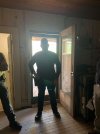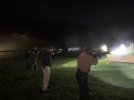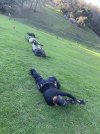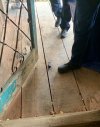AAR:
Cougar Mountain Solutions (Erick Gelhaus)
Low Light Instructors Class (16 Hours)
Feb 12 & 19, 2021
1300-2000 hours
Private Outdoor Range, Northern California/Sonoma County
"Human Factors, Use of Lights with Handgun and Patrol Rifle, Practical Application, and Decision Making"
Full disclosure, this class was provided free of charge, as Erick was working out a new format for an upcoming contract. I have not met Erik prior to this class, only talked to him online a few times. That said, I have heard many good things prior, from a lot of people I trust.
Class comprised of all current or retired LE, including two firearms instructors/trainers. My background is minimal, 3 years as a Deputy Probation Officer, 2 years of that in the field supervision unit in a relatively strange part of California. Beyond agency trainings, I have not had a “formal” firearms class. I have shot USPSA/IDPA off and on for about 8 years.




Recommended round count was approximately 400 rounds pistol, 150 rounds carbine. Erick told us off that bat that we would be keeping round count low not only due to the current ammo crunch, but also since we were working the mechanics of light use in a law enforcement context, not learning to shoot. Realistically, we probably shot around 200-250 rounds pistol, and 100 rounds of rifle. Even with the low round county, I felt it was appropriate for the content covered, and the purpose of the class.
Day one started with the normal stuff, waivers, safety briefs, introductions, etc. etc. This was followed by a solid legal update on pertinent use of force laws, beyond just the normal Tennessee v Garner and Graham v Connor. Erick showed a high level of knowledge not only in the cases themselves, but in how they apply to day to day police work. We reviewed a few of the recent changes in CA use of force (835pc), and the effect on how business is ran. Considering this is an instructor class, there was a short discussion on how this applies to agency policies, and possible issues within our respective agencies.
We continued on to the “nerdy” parts, overview of how the eye’s process light, movement, color, etc. Erick’s power point, while containing enough to be informative, was not “death by power point”, and everything was pulled into contextual examples. From there, it was off to the range.
We started the day off with working the various off hand flashlight techniques. We thoroughly covered not only the how, but the WHY, something I have not gotten from previous low light trainings. Erick sufficiently demo’d all the techniques, and we worked them dry and live during the light hours to get basics down.
After breaking for dinner, the actual low/no light shooting began. We worked through the hand held techniques, and both while incorporating WML’s, and hand held only for search and assess. Most drills were held to 1-2 shots, so the focus was working the mechanics of using the light, working angles to overcome barriers both physical and opposing light from target stand mounted lights (and idea which I am **totally** stealing for our dept trainings). Towards the end of the night, we worked decision making drills and working from vehicles. We ended day 1 with a game of “hide and seek”, which really showed how light positioning and angle of light makes a difference.
Following the end of the training day, Erick went through with all of us on the pros and cons of the day. Overall, I felt that he covered the material extremely well. The only thing brought up from just about everyone was working techniques a bit more in daylight before the low light shooting, just to be sure we had it right.
Day two started with safety brief and short review, before getting into light use inside buildings. We all pulled slides from guns, and safety checked each other before proceeding. Erick talked about hand held use while searching inside buildings, and using light angles to maximize visibility and light projection. We played another game of hide and seek inside the range cabin. I feel we learned more as the “hider”, as we were able to see how light projected, and how the “finder” would silhouette themselves in the entry way far to prematurely. This is also were I had my only weapon related failure, while drawing my frame, the TLR-1HL fell off. This is 100% a user neglect, as I had failed to check my clamp screw between the previous week, and a dept training two days prior to the second day of training. From there, we hit the range to work carbine.
Now, my job does not utilize carbines. I am the first to admit I am woefully under experienced in carbine use, as I rarely shoot my personal rifles. That said, I do not feel that hindered me much during the class. We started the day with working various light positions, using a hand held light. Again, due to this being an instructor course, we had to prepare ourselves for teaching officers with a wide variety of equipment. For me, shooting a long gun while using a hand held light was something I never considered. It was…interesting. We followed this by offhand shooting, learning a couple different methods of shooting offhand. I learned quickly that my old school click tail cap light mounted at 11 o’clock is not ideal for offhand shooting. We then worked transitions from rifle to pistol various ways, including utilizing the rifle light to illuminate for pistol shooting. After we did some basic barrier work, and improvised shooting positions (gutter prone etc). Again, we worked these drills in 1-2 rounds each, maximizing the reps vs burning ammo.
After breaking for dinner, we went back and hit all the same drills in low light. Having gotten a few more reps in during the day I feel really helped add confidence to the later low light work. We worked in a few more drills using opposing light, and moving further and further back, which really highlighted the lack of lumen/candela in some of our equipment. This was brought painfully to light during the decision making drills, which we utilized photo targets, and started pretty far back from. Each round we determined to shoot or not, and then rotated to a different target. For me, it was probably not until 15 yards back I could really determine when to shoot. I say this is mainly due to lack of output from my light being unable to overpower the opposing light from the target stands.
We finished the night again going over the good and bad of the class. Erick was extremely receptive to input, and I really hope he makes that a regular part of his debrief.
Overall, even feeling this class was a bit above my skill level, as I am a mediocre shooter and for sure not an instructor, I feel I got a ton out of the experience. While it’s pretty well known Erick has been around the block as far as both in his career, and as an instructor, I don’t feel he fell into the trap of teaching one way. A major focus, which he repeated a few times was that he wasn’t teaching “The way”, but instead trying to build various methods to accomplish a task, getting light into play to gather information and make a decision. I hope to attend more trainings with him in the future, as I really enjoyed his method and style.
Cougar Mountain Solutions (Erick Gelhaus)
Low Light Instructors Class (16 Hours)
Feb 12 & 19, 2021
1300-2000 hours
Private Outdoor Range, Northern California/Sonoma County
"Human Factors, Use of Lights with Handgun and Patrol Rifle, Practical Application, and Decision Making"
Full disclosure, this class was provided free of charge, as Erick was working out a new format for an upcoming contract. I have not met Erik prior to this class, only talked to him online a few times. That said, I have heard many good things prior, from a lot of people I trust.
Class comprised of all current or retired LE, including two firearms instructors/trainers. My background is minimal, 3 years as a Deputy Probation Officer, 2 years of that in the field supervision unit in a relatively strange part of California. Beyond agency trainings, I have not had a “formal” firearms class. I have shot USPSA/IDPA off and on for about 8 years.




Recommended round count was approximately 400 rounds pistol, 150 rounds carbine. Erick told us off that bat that we would be keeping round count low not only due to the current ammo crunch, but also since we were working the mechanics of light use in a law enforcement context, not learning to shoot. Realistically, we probably shot around 200-250 rounds pistol, and 100 rounds of rifle. Even with the low round county, I felt it was appropriate for the content covered, and the purpose of the class.
Day one started with the normal stuff, waivers, safety briefs, introductions, etc. etc. This was followed by a solid legal update on pertinent use of force laws, beyond just the normal Tennessee v Garner and Graham v Connor. Erick showed a high level of knowledge not only in the cases themselves, but in how they apply to day to day police work. We reviewed a few of the recent changes in CA use of force (835pc), and the effect on how business is ran. Considering this is an instructor class, there was a short discussion on how this applies to agency policies, and possible issues within our respective agencies.
We continued on to the “nerdy” parts, overview of how the eye’s process light, movement, color, etc. Erick’s power point, while containing enough to be informative, was not “death by power point”, and everything was pulled into contextual examples. From there, it was off to the range.
We started the day off with working the various off hand flashlight techniques. We thoroughly covered not only the how, but the WHY, something I have not gotten from previous low light trainings. Erick sufficiently demo’d all the techniques, and we worked them dry and live during the light hours to get basics down.
After breaking for dinner, the actual low/no light shooting began. We worked through the hand held techniques, and both while incorporating WML’s, and hand held only for search and assess. Most drills were held to 1-2 shots, so the focus was working the mechanics of using the light, working angles to overcome barriers both physical and opposing light from target stand mounted lights (and idea which I am **totally** stealing for our dept trainings). Towards the end of the night, we worked decision making drills and working from vehicles. We ended day 1 with a game of “hide and seek”, which really showed how light positioning and angle of light makes a difference.
Following the end of the training day, Erick went through with all of us on the pros and cons of the day. Overall, I felt that he covered the material extremely well. The only thing brought up from just about everyone was working techniques a bit more in daylight before the low light shooting, just to be sure we had it right.
Day two started with safety brief and short review, before getting into light use inside buildings. We all pulled slides from guns, and safety checked each other before proceeding. Erick talked about hand held use while searching inside buildings, and using light angles to maximize visibility and light projection. We played another game of hide and seek inside the range cabin. I feel we learned more as the “hider”, as we were able to see how light projected, and how the “finder” would silhouette themselves in the entry way far to prematurely. This is also were I had my only weapon related failure, while drawing my frame, the TLR-1HL fell off. This is 100% a user neglect, as I had failed to check my clamp screw between the previous week, and a dept training two days prior to the second day of training. From there, we hit the range to work carbine.
Now, my job does not utilize carbines. I am the first to admit I am woefully under experienced in carbine use, as I rarely shoot my personal rifles. That said, I do not feel that hindered me much during the class. We started the day with working various light positions, using a hand held light. Again, due to this being an instructor course, we had to prepare ourselves for teaching officers with a wide variety of equipment. For me, shooting a long gun while using a hand held light was something I never considered. It was…interesting. We followed this by offhand shooting, learning a couple different methods of shooting offhand. I learned quickly that my old school click tail cap light mounted at 11 o’clock is not ideal for offhand shooting. We then worked transitions from rifle to pistol various ways, including utilizing the rifle light to illuminate for pistol shooting. After we did some basic barrier work, and improvised shooting positions (gutter prone etc). Again, we worked these drills in 1-2 rounds each, maximizing the reps vs burning ammo.
After breaking for dinner, we went back and hit all the same drills in low light. Having gotten a few more reps in during the day I feel really helped add confidence to the later low light work. We worked in a few more drills using opposing light, and moving further and further back, which really highlighted the lack of lumen/candela in some of our equipment. This was brought painfully to light during the decision making drills, which we utilized photo targets, and started pretty far back from. Each round we determined to shoot or not, and then rotated to a different target. For me, it was probably not until 15 yards back I could really determine when to shoot. I say this is mainly due to lack of output from my light being unable to overpower the opposing light from the target stands.
We finished the night again going over the good and bad of the class. Erick was extremely receptive to input, and I really hope he makes that a regular part of his debrief.
Overall, even feeling this class was a bit above my skill level, as I am a mediocre shooter and for sure not an instructor, I feel I got a ton out of the experience. While it’s pretty well known Erick has been around the block as far as both in his career, and as an instructor, I don’t feel he fell into the trap of teaching one way. A major focus, which he repeated a few times was that he wasn’t teaching “The way”, but instead trying to build various methods to accomplish a task, getting light into play to gather information and make a decision. I hope to attend more trainings with him in the future, as I really enjoyed his method and style.









